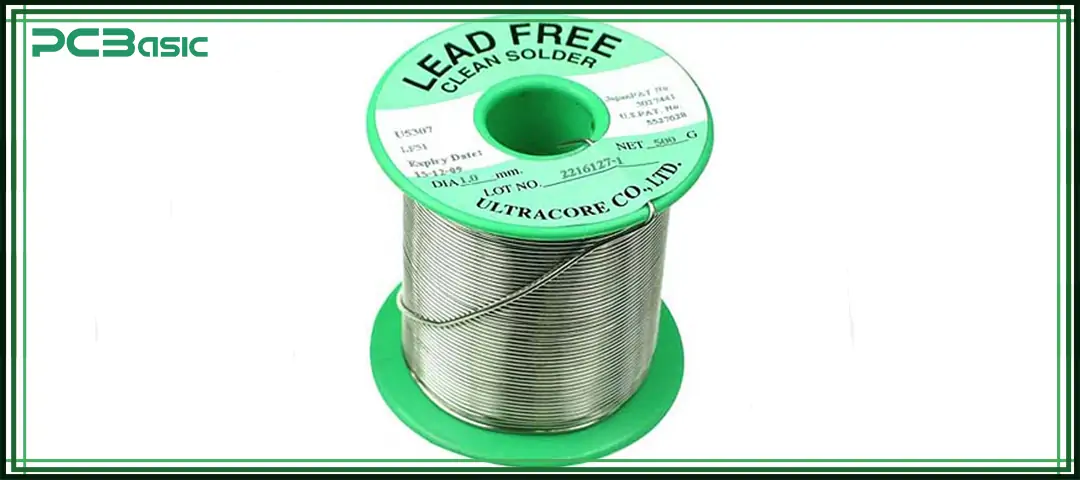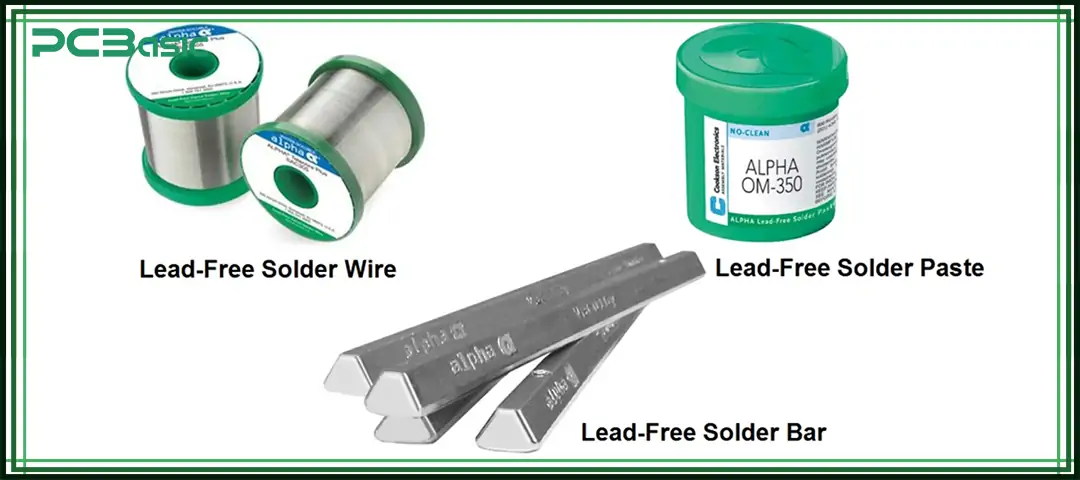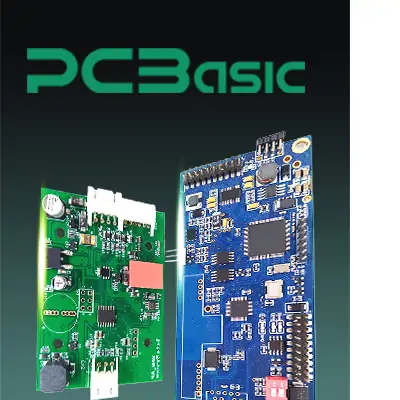

Global high-mix volume high-speed PCBA manufacturer
9:00 -18:00, Mon. - Fri. (GMT+8)
9:00 -12:00, Sat. (GMT+8)
(Except Chinese public holidays)


Global high-mix volume high-speed PCBA manufacturer
9:00 -18:00, Mon. - Fri. (GMT+8)
9:00 -12:00, Sat. (GMT+8)
(Except Chinese public holidays)
HomePage > Blog > Knowledge Base > Lead-Free Solder: A Complete Guide
In the fields of electronics and PCB assembly, lead-free solder has become a keyword that cannot be ignored. More and more countries and regions have introduced regulations such as RoHS (Restriction of Hazardous Substances), strictly restricting the use of hazardous substances. Meanwhile, people's attention to environmental protection and health safety is also constantly increasing. Therefore, manufacturers and electronics enthusiasts have chosen to abandon traditional leaded solder and adopt lead-free solder.
So, what is lead-free solder? What is the difference between it and the commonly used leaded solder? Why can lead-free solder become the new industry standard? This guide will provide you with detailed answers to these questions. You will learn about the main components of lead-free solder and the lead-free solder melting point, and how to select and correctly use different types of lead-free solder, such as lead-free solder paste and lead-free solder wire, in practical work. Whether you are an electronics manufacturer or a DIY enthusiast, this guide will help you fully understand and apply lead-free solder.

Lead-free solder is a solder alloy that does not contain lead (Pb). It is different from traditional leaded solder. Leaded solder usually contains 60% tin and 40% lead, that is, Sn60Pb40 or 63/37. Lead-free solder is designed to comply with environmental and health regulations. For example, the RoHS directive is a regulation specifically restricting harmful substances in electronic products. Nowadays, most electronic manufacturing fields, especially
Lead-free solder is used in the same way as traditional solder (such as leaded solder). It is used to firmly connect electronic components and wires to the printed circuit board (PCB), achieving reliable electrical and mechanical connections. However, lead-free solder and leaded solder have many differences in composition, performance and operation methods. These differences will affect various aspects such as the melting point and service life of lead-free solder.
The biggest difference between lead-free solder and leaded solder is that lead-free solder does not contain lead. Traditional leaded solder takes advantage of lead's low melting point and good flow characteristics. Lead-free solder uses a variety of other metals to achieve similar performance requirements.
In lead-free solder, the most common metal components are as follows:
• Tin (Sn): It is the base and main component of lead-free solder, and almost all lead-free solders are mainly composed of tin.
• Silver (Ag): It can enhance the mechanical strength and electrical conductivity of solder joints, making the connection after soldering more solid and stable.
• Copper (Cu): It can enhance the mechanical properties of solder joints and at the same time help lower the overall melting point, making lead-free solder easier to melt and handle.
• Bismuth (Bi): Bismuth is commonly used in lead-free solder formulations that require low-temperature soldering. It can significantly lower the melting point of the alloy and is suitable for heat-sensitive components.
• Antimony (Sb), Nickel (Ni), and Zinc (Zn): These elements are used less frequently but are added according to specific needs, such as enhancing corrosion resistance, improving solderability, or optimizing the alloy structure.
The most common lead-free solder alloy type is SAC305, which is composed of 96.5% tin, 3.0% silver and 0.5% copper. This formula is widely used in modern electronic manufacturing and is commonly found in lead-free solder wire and lead-free solder paste, meeting the assembly and production requirements of most electronic products.
When choosing lead-free solder, there are three common types:

1. Lead-Free Solder Wire
Lead-free solder wire can be solid or have a flux core. It is mainly used for hand soldering, equipment repair and making circuit prototypes. Lead-free solder wire comes in different diameters and compositions, with SAC305 being the most common. Lead-free solder wire has good fluidity and is suitable for soldering through-hole components, point-to-point wiring and manual PCB assembly.
2. Lead-Free Solder Paste
Lead-free solder paste is used in surface mount technology (SMT) processes. It is a paste made from mixing lead-free solder powder and flux. Solder paste can be applied to a PCB by stencil printing or syringe dispensing. During the reflow soldering process, the lead-free solder paste melts and forms a firm solder joint.
3. Lead-Free Solder Bar
Lead-free solder bar is a solid bar-shaped solder mainly used in wave soldering, manual dip soldering or large-scale automated soldering equipment. It is generally directly put into the furnace, heated and melted, providing solder for automated production lines or large-scale soldering. Lead-free solder bars are suitable for robotic soldering and special automated processes.

Time is money in your projects – and PCBasic gets it. PCBasic is a PCB assembly company that delivers fast, flawless results every time. Our comprehensive PCB assembly services include expert engineering support at every step, ensuring top quality in every board. As a leading PCB assembly manufacturer, we provide a one-stop solution that streamlines your supply chain. Partner with our advanced PCB prototype factory for quick turnarounds and superior results you can trust.
As we mentioned earlier, the common components of lead-free solder mainly include tin (Sn), silver (Ag), and copper (Cu), among which the most common formulation is SAC305 (tin 96.5%, silver 3%, copper 0.5%). The melting point of lead-free solder of this type is usually between 217°C and 221°C. In addition, there are some other formulations, such as tin-copper (Sn-Cu) and tin-silver (Sn-Ag), whose melting points are mostly above 200°C.
Because lead-free solder has a higher melting point, it will have some effects in the actual soldering process. When soldering, the soldering iron and reflow soldering oven need to be set to a higher temperature to ensure that the lead-free solder melts smoothly and forms solder joints. At the same time, the risk of sensitive components being damaged in high-temperature environments will increase, so special attention should be paid to temperature control. In addition, soldering time should also be appropriately adjusted according to the actual situation to avoid cold solder joints. Mastering the lead-free solder melting point is crucial, which helps ensure the stability of the soldering process and the reliability of the solder joints.
Soldering with lead-free solder is similar to soldering with leaded solder, but there are some points that require special attention:
First of all, a higher temperature should be used. Lead-free solder has a high melting point, so it is recommended to set the soldering iron temperature to 350-370 °C (662-698 °F) during soldering. If lead-free solder paste is used for reflow soldering, the temperature profile of the oven needs to be adjusted according to the melting point.
Secondly, the appropriate flux should be used. High-quality flux can help lead-free solder prevent oxidation and improve wetting. Commonly used ones are lead-free solder paste and flux-cored lead-free solder wire.
In addition, it is recommended to preheat the circuit board and components first. This can reduce thermal shock and also facilitate smoother flow and adhesion of lead-free solder.
The heating time should be controlled during soldering. Although the temperature is high, do not keep the soldering iron at the same spot for a long time to avoid damaging the PCB or components. Lead-free solder joints may form more slowly than leaded solder, so be patient and try to finish the operation as quickly as possible.
After soldering is completed, the solder points should be inspected. Lead-free solder joints are usually darker or slightly grainy, not as shiny as leaded solder joints. It is recommended to use a magnifying glass for inspection to ensure there are no cold solder joints or poor wetting.
Finally, it should be thoroughly cleaned. The flux residue produced by lead-free solder is more likely to corrode PCBs. After soldering is completed, especially when using lead-free solder paste or lead-free solder wire, the surface of the PCB board should be thoroughly cleaned to ensure long-term reliability.

Leaded solder is a traditional solder material that contains lead (Pb). The most common lead solder is an alloy of tin and lead, such as Sn60Pb40 (60% tin, 40% lead). Leaded solder has the advantages of a low melting point, good flowability and bright solder joints. In the soldering of electronic components and the assembly of circuit boards, leaded solder is widely used. But because lead is toxic and harmful to the environment, more and more electronic manufacturing enterprises are now using lead-free solder instead of leaded solder.
The debate of leaded vs lead-free solder is ongoing in electronics. Here are the key points:
|
Feature |
Leaded Solder |
Lead-Free Solder |
|
Composition |
Tin + Lead |
Tin + Silver/Copper/Other Metals |
|
Melting Point |
~183°C |
~217–221°C |
|
Joint Appearance |
Shiny, smooth |
Dull, sometimes grainy |
|
Wetting Ability |
Excellent |
Slightly lower |
|
Health/Environmental |
Toxic, hazardous |
Non-toxic, RoHS compliant |
|
Regulation |
Restricted/banned |
Required in most new devices |
|
Usage |
Legacy, hobby, repair |
Industry standard |
Although leaded solder is easier to handle, lead-free solder has more advantages in terms of health, environmental protection and regulatory compliance. Modern lead-free solder paste and lead-free solder wire have been optimized to significantly minimize the performance gap.
Nowadays, the electronics industry generally opts for lead-free solder. Lead-free solder has obvious advantages in terms of regulatory compliance, environmental protection and worker health. Understanding the lead-free solder melting point and mastering the difference between leaded and lead-free solder are critical. Additionally, it is very important for practitioners in the electronics industry to choose the appropriate lead-free solder paste or lead-free solder wire according to actual needs.
Although the shift from leaded solder to lead-free solder requires changes in process and equipment, the industry has recognized and accepted this safer and more environmentally friendly option.
Can you mix leaded and lead-free solder?
It is technically possible to mix leaded solder and lead-free solder on the same joint, but it is not recommended. The resulting joint will have unpredictable properties and a melting point somewhere between the two, which can lead to reliability issues. For consistent results, avoid mixing leaded vs lead-free solder—stick with one or the other.
Is rosin core solder available in lead-free versions?
Absolutely! Lead-free solder wire is commonly available with a rosin or no-clean flux core, just like traditional leaded solder. When shopping for lead-free solder wire, look for "rosin core" on the label. This makes it easy to use lead-free solder for both electronics and electrical work.
Is lead-free solder safe?
Yes, lead-free solder is specifically designed to be safe for both users and the environment. Unlike leaded solder, it does not pose a risk of lead poisoning. However, always use good ventilation, as flux fumes from lead-free solder paste or lead-free solder wire can still be irritating.
Does lead-free solder last as long as leaded solder?
Lead-free solder technology has improved dramatically. Modern lead-free solder joints, when made correctly, are just as reliable and long-lasting as those made with leaded solder. The main risk comes from improper technique—due to higher lead-free solder melting point, cold joints are a bit more likely if soldering is rushed.

Assembly Enquiry
Instant Quote
Phone contact

+86-755-27218592
In addition, we've prepared a Help Center. We recommend checking it before reaching out, as your question and its answer may already be clearly explained there.
Wechat Support

In addition, we've prepared a Help Center. We recommend checking it before reaching out, as your question and its answer may already be clearly explained there.
WhatsApp Support

In addition, we've prepared a Help Center. We recommend checking it before reaching out, as your question and its answer may already be clearly explained there.
